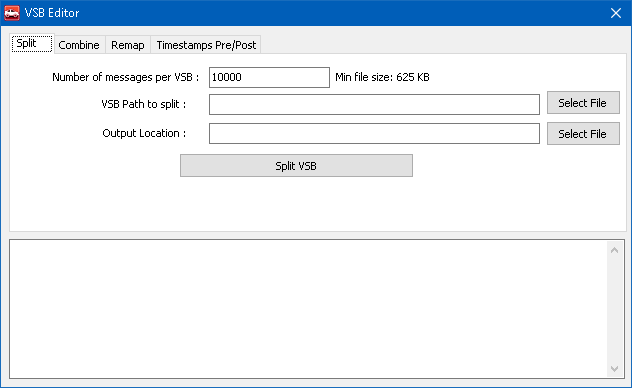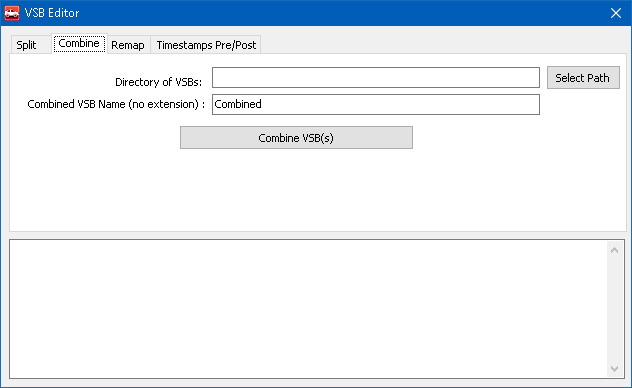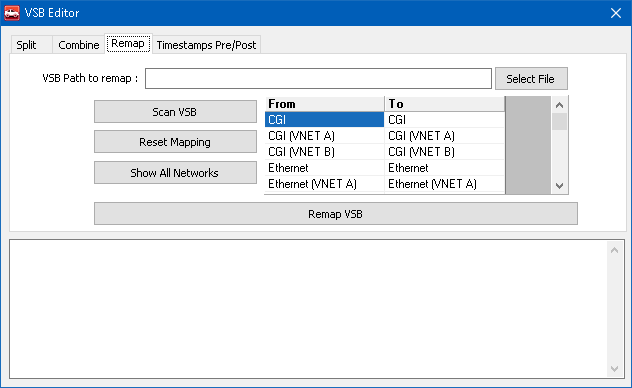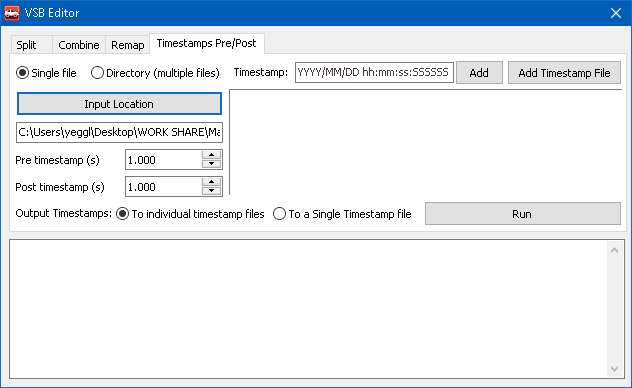 VSB Editor
VSB Editor
Vehicle Spy can save network message traffic to Vehicle Spy Binary (VSB) files using Messages view,
capture function blocks, or Data Cache Disk Streaming.One benefit of the VSB file format is its
smaller size compared to other file types.VSB files do NOT store decoded signals or user notes.Also, VSB files are not easy to read with standard file editors; so use File >
Review Buffer to read them.
VSB files can be changed with the VSB Editor in the following ways:
- Split one VSB file into smaller files.
- Combine multiple VSB files into one file.
- Remap networks within a VSB file.
The VSB Editor is opened from the Tools > File Conversions menu.
Split VSB
Use the Split VSB tab (Figure 1) to split one VSB file into multiple smaller VSB files:
- Enter the Number of messages per VSB to set how big each of the split files will be.
- Click Select File and pick the VSB source file to split.
- Click the second Select File and pick the Output Location for the split VSB file.
- Click Split VSB to split the file according to the settings made.
The bottom area shows the status of split actions being performed. Vehicle Spy puts the split VSB files in the same directory as the source file.Each split file name is the source file name
appended with a sequence number.

Figure 1: The VSB Editor can split one VSB file into smaller files.
Combine VSBs
Use the Combine VSBs tab (Figure 2) to combine all VSB files within a directory into one VSB file:
- Click Select Path and pick the directory that has the VSB source files to combine.
- Enter a Combined VSB Name (without extension) for the final combined file.
- Click Combine VSBs to pull the files together.
The bottom area shows the status as the VSB files are joined together.Vehicle Spy puts the combined VSB file in the same directory as the source files.

Figure 2: The VSB Editor can combine multiple VSB files into one file.
Remap VSB
Use the Remap VSB tab (Figure 3) to change network assignments within a VSB file:
- Click Select Path and pick the VSB file to be remapped.
- Click Scan VSB to update the "From" column with the networks currently in the VSB file.
- Select desired networks in the "To" column. (Figure 1:
 )
)
- If needed, use Reset Mapping to reset all "To" networks back to their original "From" settings.
- Click Remap VSB to make a new VSB file with the remapped networks in the "To" column.
The bottom area shows the status of remapping actions being performed.Vehicle Spy puts the remapped VSB file in the same directory as the source file.The remapped VSB file name is the
source file name appended with the text "Remapped" to avoid overwriting the original file.
Show All Networks is not needed for remapping a VSB file, so do not use it.

Figure 3: The VSB Editor can remap the networks within a VSB file.
Timestamps Pre/Post
Use the Timestamps Pre/Post (Figure 4) to edit a VSB file based on a trigger time:
- Click Single File or Directory (multiple files) to edit either a single file, or all the files in a directory
- Enter a timestamp and click Add, or click on Add Timestamp File to add a timestamp to be used to evaluate Pre/Post times.
- Click on Input Location to select either a file if Single File is selected, or a directory if Directory (multiple files) is selected.
- Set the Pre and Post trigger times to be captured under Pre timestamp (s) and Post timestamp (s) respectively
- Select To individual timestamp files to capture each trigger event to a seperate file, or select To a Single Timestamp file to capture all trigger events as one file.
- Click on Run to edit the selected VSB file to the parameters set above.
The bottom area shows the status of the Pre/Post collection as it is being processed.

Figure 3: The VSB Editor can remap the networks within a VSB file.
 Spy Documentation - (C) Copyright 1997-2022 Intrepid Control Systems, Inc.
Spy Documentation - (C) Copyright 1997-2022 Intrepid Control Systems, Inc.


 )
)
